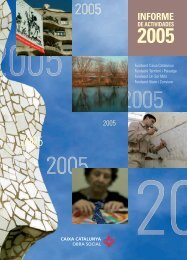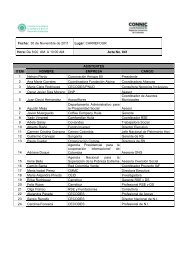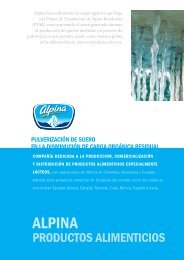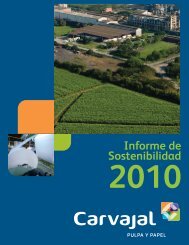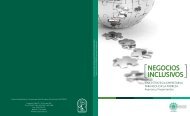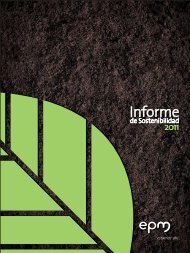Setting new standards - Friends Life
Setting new standards - Friends Life
Setting new standards - Friends Life
Create successful ePaper yourself
Turn your PDF publications into a flip-book with our unique Google optimized e-Paper software.
FINANCIAL STATEMENTS<br />
IFRS FINANCIAL STATEMENTS<br />
EEV SUPPLEMENTARY INFORMATION<br />
Notes to the consolidated accounts continued<br />
1. Accounting policies continued<br />
contracts are finite and are amortised as the revenue on those<br />
contracts is earned, which equates to a straight-line basis over the<br />
estimated average contract term, depending on the nature of the<br />
contract, with amortisation being charged to the income statement.<br />
The amortisation period is reviewed at each financial year-end.<br />
The estimated useful lives have been assessed as follows:<br />
2006 2005<br />
Investment trusts 10 years 20 years<br />
Insurance 10 years 10 years<br />
Institutional 6 years 10 years<br />
Retail 10 years 10 years<br />
The useful lives of Investment trust and Institutional management<br />
contracts were reduced during the year, as set out in note 2(h).<br />
(c) Present value of acquired in-force business (PVIF)<br />
On acquisition of a portfolio of insurance contracts or investment<br />
contracts, either directly or through the acquisition of a subsidiary<br />
undertaking, the net present value of the Group’s interest in the<br />
expected pre-tax cash flows of the in-force business is capitalised in<br />
the balance sheet as an intangible asset. This is amortised over the<br />
anticipated lives of the related contracts which typically varies<br />
between 5 and 50 years.<br />
(d) Other intangible assets<br />
Distribution lists, brands and licences acquired are capitalised at<br />
cost, being the fair value of the consideration paid. Software is<br />
capitalised on the basis of the costs incurred to acquire and to bring<br />
into use. Direct costs of internally generated software are capitalised<br />
as intangible assets.<br />
Other intangible assets have finite useful lives and are carried at cost<br />
less accumulated amortisation and impairment. Amortisation is<br />
calculated using the straight-line method to allocate the cost over<br />
the estimated useful lives of the intangible asset as follows:<br />
Distribution lists<br />
Brands<br />
Licences<br />
Software<br />
10–15 years<br />
10 years<br />
3–5 years<br />
3 years<br />
Subsequent expenditure on other intangible assets is capitalised only<br />
when it increases the future economic benefits embodied in the specific<br />
asset to which it relates. All other expenditure is expensed as incurred.<br />
1.3.9 Property and equipment<br />
(a) Owned assets<br />
Land and buildings are initially recognised at cost and subsequently<br />
measured at fair value. Revaluations are performed annually by<br />
independent valuers, who hold a recognised and relevant professional<br />
qualification and have recent experience in the location and category of<br />
properties being valued. Valuations are performed with sufficient regularity<br />
such that the carrying amount does not differ materially from that which<br />
would be determined using fair values at the balance sheet date. The fair<br />
78 <strong>Friends</strong> Provident Annual Report & Accounts 2006<br />
value is the amount for which a property could be exchanged between<br />
knowledgeable and willing parties in an arm’s length transaction.<br />
Properties occupied by the Group are held at fair value on the basis<br />
of open market value at the date of revaluation. Revaluation<br />
surpluses are credited to the revaluation surplus in shareholders’<br />
equity. Decreases that offset previous increases of the same asset<br />
are charged against the revaluation surplus directly to equity; all<br />
other decreases are charged to the income statement.<br />
Equipment is recognised at cost less accumulated depreciation and<br />
impairment losses.<br />
(b) Depreciation<br />
Depreciation is charged so as to write off the cost of an asset net of<br />
the estimated residual value, using the straight-line method, over the<br />
estimated useful life of each part of an item of property and<br />
equipment, as follows:<br />
Motor vehicles<br />
Computer hardware and related software<br />
Fixtures, fittings and office equipment<br />
3–4 years<br />
1–4 years<br />
3–10 years<br />
Residual values and useful lives are reviewed at each reporting date<br />
and adjusted if appropriate.<br />
(c) Disposal and derecognition<br />
An item of property and equipment is derecognised upon disposal or<br />
when no further future economic benefits are expected from its use.<br />
Any gain or loss arising on derecognition of the asset is included in<br />
the income statement in the year the asset is derecognised. Any<br />
revaluation reserve relating to the particular asset being disposed of<br />
or no longer in use is transferred to retained earnings.<br />
1.3.10 Investment properties<br />
Investment properties comprise land and/or buildings that are not<br />
occupied by the Group and are held either to earn rental income or<br />
for capital appreciation, or for both.<br />
Investment property is initially included in the balance sheet at cost<br />
and subsequently measured at its fair value, which is supported by<br />
market evidence, based on annual valuations by independent valuers<br />
who hold a recognised and relevant professional qualification and have<br />
recent experience in the location and category of investment property<br />
being valued. Movements in the fair value of investment properties<br />
are taken to the income statement in the period in which they arise.<br />
1.3.11 Fair values of financial instruments<br />
Fair values of listed financial instruments are based on market bid<br />
price for assets and offer price for liabilities at the close of business on<br />
the balance sheet date. For unlisted financial instruments broker or<br />
dealer price quotations are obtained. If prices are not readily available,<br />
the fair value is based on valuation techniques. Certain financial<br />
instruments, including financial derivative instruments, are valued<br />
using pricing models that consider, among other factors, contractual<br />
and market prices, correlation, time value of money, credit risk, yield<br />
curve volatility factors and/or prepayment rates of the underlying<br />
positions. The use of different pricing models and assumptions could<br />
produce materially different estimates of fair values.







